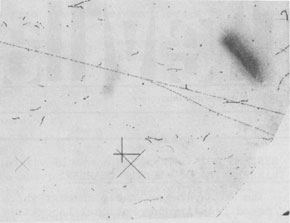All Systems Go!
On Transplanted 30" Bubble Chamber
The 30" hydrogen bubble chamber which was moved from Argonne National Laboratory in summer of 1971 to the Bubble Chamber area of the Neutrino Laboratory at NAL, was successfully tested in its new home on November 9th, 1971. Tracks of cosmic rays and of secondary electrons from gamma ray sources were observed.
From April of 1964 until April of 1971, the chamber was one of the main research facilities at Argonne. Over 50 experiments (a total of nearly 14 million pictures) were performed for groups from the major research centers in the U. S. The chamber was originally constructed for use at the Argonne zero gradient synchrotron (ZGS) by a Midwestern Universities Research Association group in Madison, Wisconsin, under the direction of Dr. W. D. Walker of Duke University. Dr.Walker also be worked on experiments done with the chamber at NAL.
As plans for experiments at NAL evolved from 1969-71, it became apparent that a bubble chamber facility should be available at NAL as soon as beam was available. An agreement was reached between NAL and ANL in December of 1970, and in April 1971 plans were completed for the buildings and major services to be provided for the new facility by NAL, while ANL accepted responsibility for the move and installation aimed at initial operation of the bubble chamber at NAL in November, 1971. Argonne also operated the facility during the first year of its use in experiments at NAL.
Dr. Louis Voyvodic, who had been group leader of the 30-inch bubble chamber section at Argonne, had also directed the reactivating operations at NAL. "The uniquely high optical precision and the unusually high magnetic field of 32,000 gauss in this chamber will play important roles in the experiments to be performed at NAL," he noted, "building on the proven performance already achieved with this facility at Argonne."
Approved plans for experiments with this bubble chamber are thus described by Dr. Voyvodic: "First, a series of eight 'quickie' experiments with the 'bare' chamber were scheduled, utilizing the full energy range of NAL proton and meson beams, in order to survey the kinds of interactions which can be studied for the first time with these particles."
A group of Argonne scientists who are especially familiar with this chamber conduct the first experiment. Other "quickie" experiments included researchers from NAL, UCLA, Brookhaven National Laboratory, CERN, University of Michigan, University of Rochester, Lawrence Berkeley Laboratory, and University of California at Davis.
"Next," says Dr. Voyvodic, "came a systematic experiment in which the chamber were aided by a hybrid system with wide gap optical spark chambers." Four laboratories-Michigan State University, Iowa State University, University of Maryland and Argonne carried this work out, with additional participation by Duke University, University of Toronto, Purdue University, University of Notre Dame and University of Wisconsin.
And, "additional experiments were conducted by another group of nine laboratories who provided further wire-chamber and computer instrumentation to enhance the hybrid capabilities of this unique bubble chamber installation," according to Dr. Voyvodic.
The successful testing of the chamber in its new surroundings started on November 1, 1971, when the main components began a "cooldown" reaching down to 450 degrees below zero (-450°F). At this temperature, controlled boiling of liquid hydrogen was achieved to produce particle tracks on November 9th.
During the checkout tests of the chamber, the electrical power supply for the powerful magnet in the system arrived from California. This was readied to allow full experimental operation, with the bubble chamber group pausing occasionally to check on progress at the NAL Main Ring. The 100 to 500 BeV beams brought exciting events to this group of scientists in the Bubble Chamber area.




